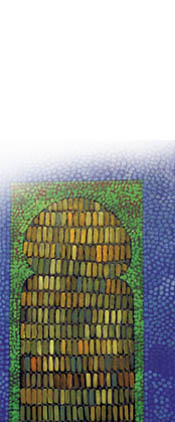
|
 |
Extract from: Catalog for the exhibiton Muqarnas: Paintings by Lubna Agha
and Architectural works by Sharif Senbel
Niagara Artist's Center, Saint Catharine's, Toronto, Canada
August, 2006
Muqarnas: Converging Sites
By Nadia Kurd, Curator
South Asian Visual Arts Collaborative
I went to the mosque
when no one was there.
No One was sweeping up.
She said: This place is just a place.
Light is everywhere. Go, live in it.
The Mosque is under your feet,
wherever you walk each day.
- “My Little Mosque” by Mohja Kahf.
The mosque has many uses; it is a place for prayer, a community centre, and for learning. For the Muslim diaspora, the mosque plays a pivotal role in anchoring the community in new locations. For it is in these spaces that Muslims can practice and define the characteristics of Islam...
With a career spanning over thirty years, Pakistani-American artist Lubna Agha explores the traditional features of Islamic architecture through the medium of painting. Her large scale work utilizes features such as geometric patterning, and a repetition of arches- both quintessentially Islamic in aesthetic, however these images offer a much more materially grounded in painting. For Lubna, these paintings were influenced by a trip she had made
to Morocco, and a result, the strong architectural symmetry in works such as Star 1 (2005), and Fountain (2005). Not only do these images integrate elements of architecture but also incorporate the style of pointillism. This method of painting gives her subject matter a distinct brilliance in colour and shape. The abstract images in her work challenge some of the immoveable qualities of architecture to provide an ephemeral sense of two contradictory senses- both of infinity and oneness.
Lubna’s work does not incorporate the conventions of a square canvas, but rather, the perimeters of her work take on architectural features such as scale and shape. The effect is considerably more dynamic and breathes life into constructed Muslim spaces. For example, Four Windows (2005) replicates actual windows of traditional mosques, yet her approach provides a portable means to experience such spaces in different environments.
|
 |
 |


